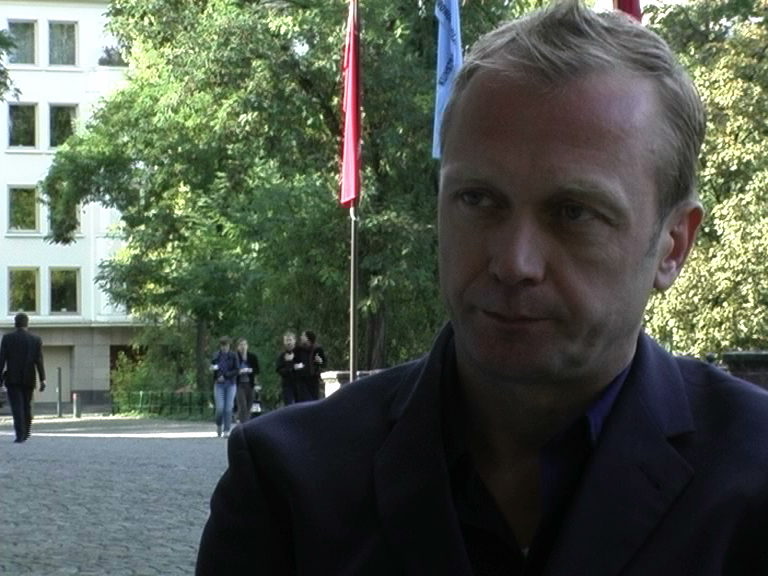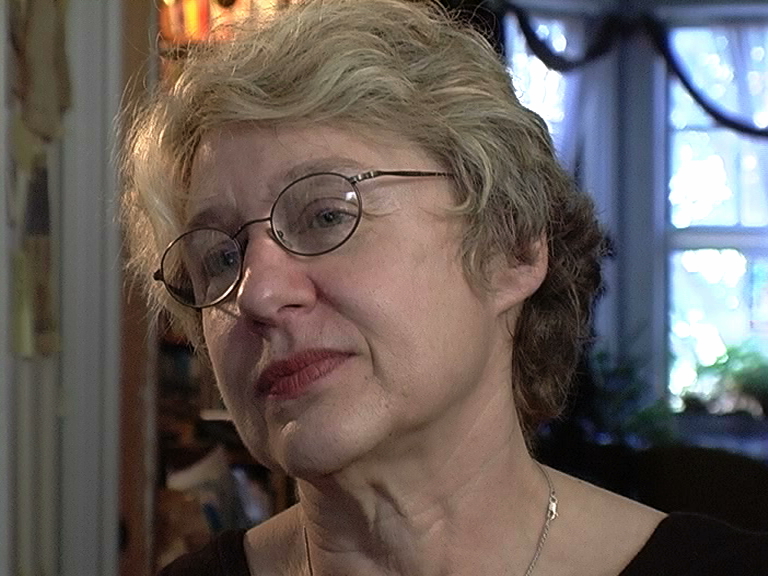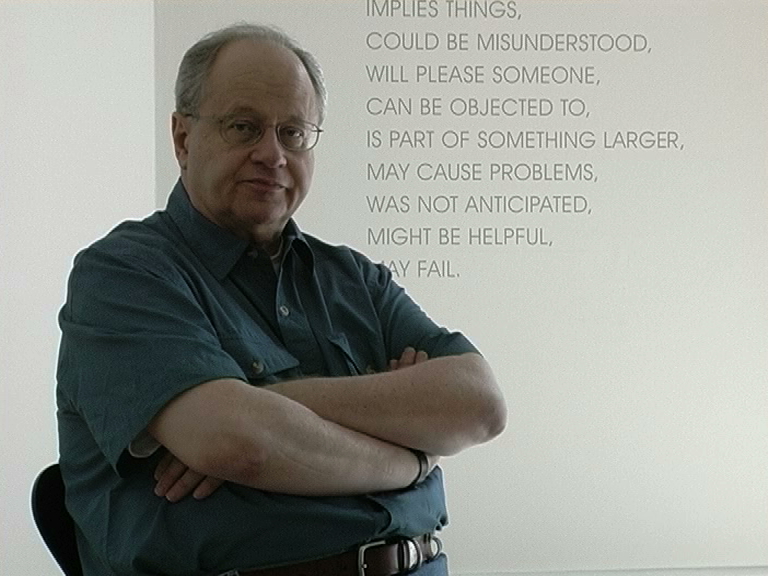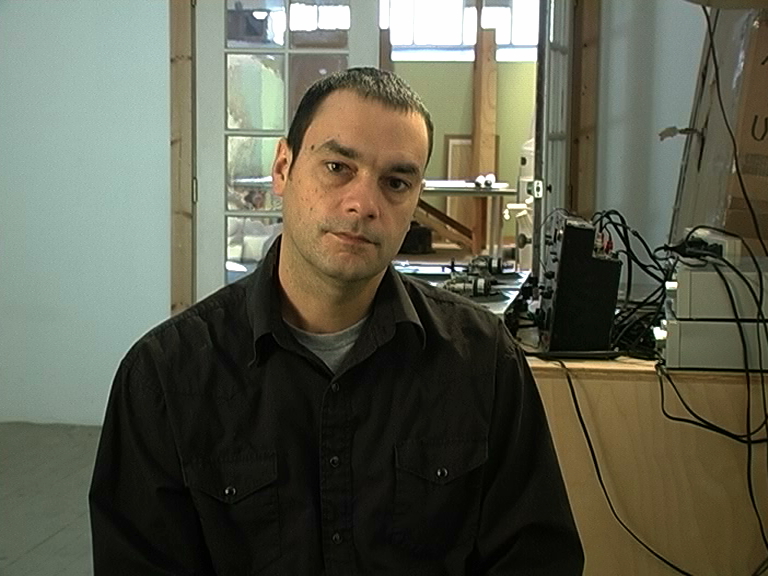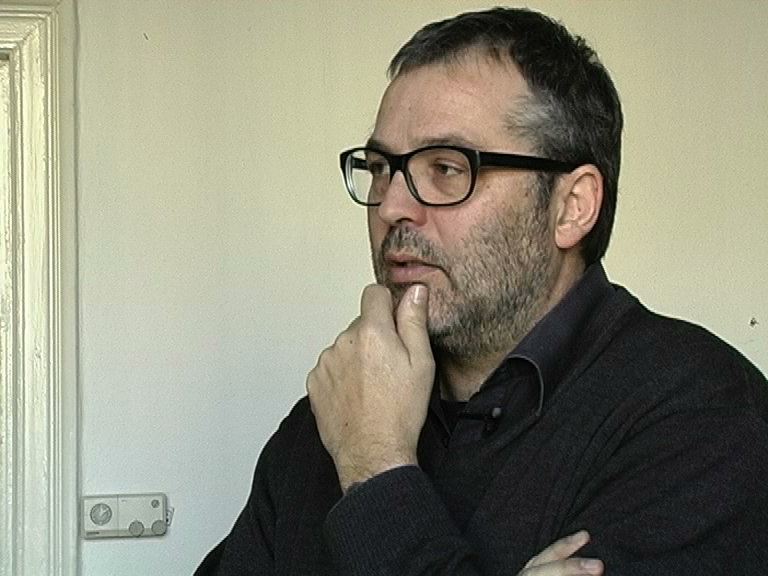S.R.: Once you wrote in a catalogue… Would you say the same in relation to persons or individuals?
J.M.: Yes. And I guess, just in terms of semiotics, it’s unavoidable that you have to deal with representations. And I suppose also the generation of artists I come from, this notion of representation was a key issue. And then the following generation of artists they moved away from representation, going more to design for example something like that. But I guess I’m staying with that, those questions.
S.R. Do you agree that this exhibition collects subjective announcements which are at the same time advertisements for the people themselves?
JM.: I didn’t quite understand the question.
S.R.: …kind of advertisement of the people, they try to represent themselves. It’s this self-referential representation.
JM: Yes, absolutely. And may be to specify that a bit more, all the representations are as individuals, there’s never a representation, I guess, you know I guess by the very nature of the kinds of ads that they are, people don’t represent themselves as a class or as a larger group, but as isolated individuals.
S.R.: One question I wanted to ask you is, exactly, what this work is about. How do you see this in relation to the advertisement for the self in relation to the work-representations of the so-called “original“ in art, the art person, the artist?
J.M.: It’s funny because part of my impulse for doing that came out of some of those questions. Because I felt like, well, here I am appropriating ads from other people without having written such an ad myself and then (Unterbrechung)
What you talk about is partly what prompted this piece, because here I am appropriating ads from other people, without ever having taken out such an ad myself. Initially I thought I will try to write my own ad and subject myself to the same process, but in the end I ended up not doing that. In the end, I took myself out of the equation. Also, given the view that I have on the whole process, I don’t think that it’s in some ways possible to represent yourself. I was kind of setting a hard problem for myself since I didn’t really believe in the process. I guess the funny part is, when I’ve talked about this work to other people, I would run into a few who‘ve said, Oh, my friend met her husband through personals ads. Or something like that which puts a much more kind of cheery spin on the whole thing. But I guess I respond to a kind of tragic element that I see in it.
S.R.: Do you, like for instance Franz Boas did for anthropology, bring an empirical level into Conceptual art or is it more a gesture in the long hostory of art? How do you conceive this?
J.M.: I think it’s more a gesture. I can claim that the information is real to a certain extent. And that it is objective to a certain extent, but I wouldn’t hold this up as a rigorous kind of sociology, for example. That’s a good question, because it’s another facet of the process, kind of posing as a sociologist. On the one hand I try to bring as much of my own insight to the material as I can. But I don’t have the training and there’s a kind of subjectivity of my own that feeds into the methods that I’ve kind of cobbled together. In terms of sociologists who I’ve been influenced by – I don’t really know Boas’ work at all, but Bourdieu’s diagrammatic approach of course. Also I studied some linguistics and was very much interested in the work of a socio-linguist named William Labov. Many of his studies were based on just very small amounts of information. He put together a famous one was about the class-stratification of the sound “r” in New York City. And for that he went to three different department stores. I think Bloomingdales, Macy’s and Klein’s. So these were kind of upper, middle-class and lower middle-class stores. And he just spoke to people who were shopping there and made notes. His theory was that at the time he did the study the hard “r”, which is pronounced [a:], was a more upper-class pronunciation and the soft “r”, that is like “pa:k the ca:”, that kind of soft “r” which was the same accent that Kennedy had – that is in pronunciation of the “r” –, but was also acquaintant with the Brooklyn accent in New York, that is a more proletarian accent. But anyways, he was able to find these oppositions based on relatively small amount of data that he just gathered personally himself and was able to take this phonetic material back to a kind of index of class structure. That’s what I found compelling about his work.
S.R.: I have two questions are especially for this film I’m interested in questions of influences and originality or faked originality. So, what do you think, what is your strongest influence?
J.M.: That’s tough to say. Do you mean for this work or overall?
S.R.: Well, overall.
J.M.: One would have to be my education, some of the teachers I worked with were Michael Asher, John Baldessari, Douglas Huebler and Yvonne Rainer. I think they all made an impact on my development as an artist. (break)
Probably the things that were most influential were sources and people who I encountered earlier on. I think that when you are younger, you are more able to take things in and you can be more influenced. I think that was the case of me. Relatively early on I read Bataille‘s work and that made an impression on me and all of Sartre’s work that had been translated into English. Those were two key things. With Bataille it was more his essays than his novels. And then just where and when I grew up. Coming from the Mid-West and growing up in the 1960s and 70s which was politically a very polarized time in the U.S. I grew up not far from Kent State. There was the Kent State Massacre which was a kind of turning point in resistance to the war in Vietnam. The kind of popular culture of where I grew up and the political environment shaped me, too.
S.R.: Which practice in the history of art is you favorite? Can you say that? Apart from the influences?
J.M.: A favourite of practice, by that you mean a movement or a genre of art-making?
S.R: Yes.
J.M.: That’s a tough one. I guess I can’t say, really. In the context of this film it would be sort of redundant to say Conceptual art. I think two of the artists who I most admire now are Adrian Piper and Dan Graham. I think they are two of the most important American artists. A lot of it depends on which work and which context and those kinds of things.
S.R.: What is your aim with your artistic practice?
J.M.: I think to produce some kind of social reflection that I don’t think that art can be transformational in and of itself, outside of political processes but that would stimulate that kind of thing. I think that’s the most an artist can hope for.
S.R.: one last question: Do you think that the conceptual paradigms are still in function or, could a new conceptual approach be realized?
J.M.: I think that the precedent of Conceptual art – and, for me, I like to use that term in a very specific way, restricting it to the first generation of conceptual artists. And then since that time I think that paradigm has undergone continuous transformations. Some of the early notions that were attached to it, like “dematerialization“ or standing outside of the market, some of the idealist components that were problematic, have not necessarily been resolved but they have been stripped away. Certainly in the 80s the idea of marketability with certain forms of post-conceptual art came back into the market with a vengeance. So I think it’s a process of working through those things. I’m not someone who longs for the good old days. I think a lot of the transformation has been really positive. And for me one text I refer to in that regard a lot, it has influenced my thinking about what’s going on now in a kind of historical process, is Hal Foster’s text “Who is Afraid of the Neo-Avant-Garde?” Where he looks at the kind of absolute declarations that Peter Burger made, try to hypostasize, you know, one short moment of Dada practices as an avant-garde absolute. And I think that Foster really productively looks at how subsequent artists in a less dramatic way have worked through the implications of those aspects of Dada-practice. I think the same holds true with Conceptual art.
S.R.: If you reflect upon everything you said, do you want to add something?
J.M.: It’s just that the irony of our conversation is, that the interview is another process of self-representation. Since I teach, I often speak about other artists’ work before students. Oftentimes for me the most difficult challenge is to speak about my own work, the newest work. After it’s a few years old it becomes easier to kind of objectify it. Maybe it’s a funny part of our conversation that I’m doing the very thing that the advertisers in the personals ads are doing in this case. (laughs)
S.R.: Thank you very much.
J.M.: Thank you too.




























